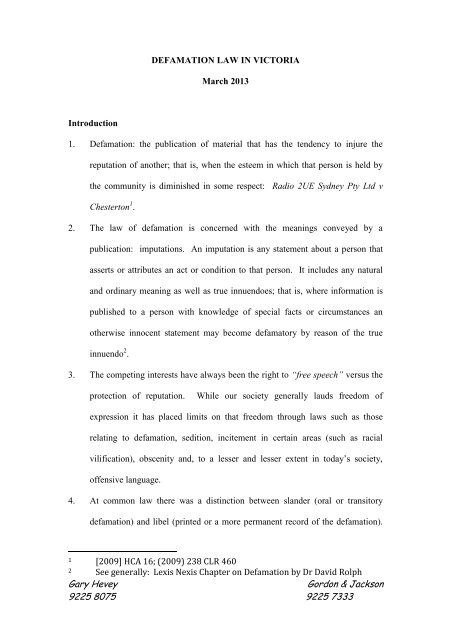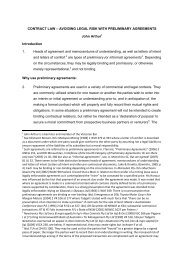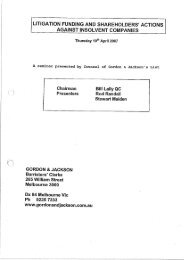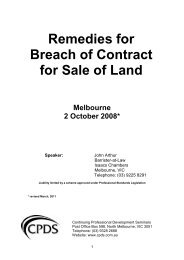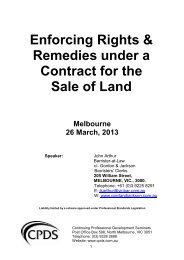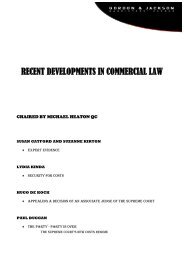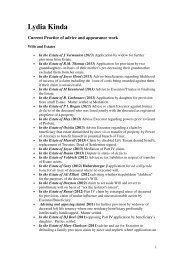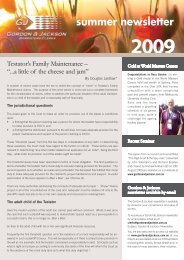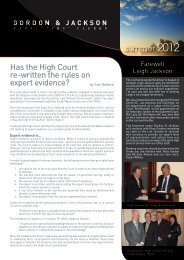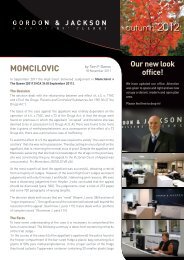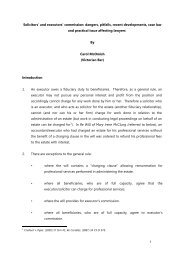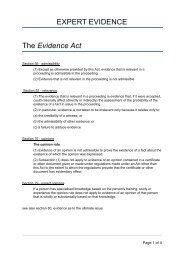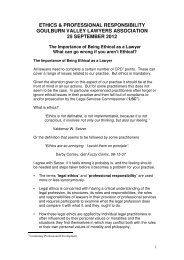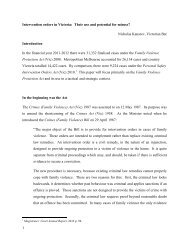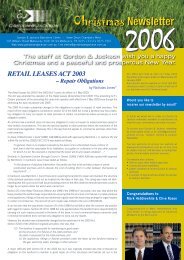Gary Hevey Gordon & Jackson 9225 8075 9225 7333 ...
Gary Hevey Gordon & Jackson 9225 8075 9225 7333 ...
Gary Hevey Gordon & Jackson 9225 8075 9225 7333 ...
Create successful ePaper yourself
Turn your PDF publications into a flip-book with our unique Google optimized e-Paper software.
DEFAMATION LAW IN VICTORIA<br />
March 2013<br />
Introduction<br />
1. Defamation: the publication of material that has the tendency to injure the<br />
reputation of another; that is, when the esteem in which that person is held by<br />
the community is diminished in some respect: Radio 2UE Sydney Pty Ltd v<br />
Chesterton 1 .<br />
2. The law of defamation is concerned with the meanings conveyed by a<br />
publication: imputations. An imputation is any statement about a person that<br />
asserts or attributes an act or condition to that person. It includes any natural<br />
and ordinary meaning as well as true innuendoes; that is, where information is<br />
published to a person with knowledge of special facts or circumstances an<br />
otherwise innocent statement may become defamatory by reason of the true<br />
innuendo 2 .<br />
3. The competing interests have always been the right to “free speech” versus the<br />
protection of reputation.<br />
While our society generally lauds freedom of<br />
expression it has placed limits on that freedom through laws such as those<br />
relating to defamation, sedition, incitement in certain areas (such as racial<br />
vilification), obscenity and, to a lesser and lesser extent in today’s society,<br />
offensive language.<br />
4. At common law there was a distinction between slander (oral or transitory<br />
defamation) and libel (printed or a more permanent record of the defamation).<br />
1 [2009] HCA 16; (2009) 238 CLR 460<br />
2 See generally: Lexis Nexis Chapter on Defamation by Dr David Rolph<br />
<strong>Gary</strong> <strong>Hevey</strong><br />
<strong>Gordon</strong> & <strong>Jackson</strong><br />
<strong>9225</strong> <strong>8075</strong> <strong>9225</strong> <strong>7333</strong>
2<br />
That distinction is abolished by the Defamation Act 2005 3 . The ever changing<br />
world of communications through social media is leading to new challenges as<br />
will be highlighted later in this paper.<br />
5. The tort of defamation provides a remedy in damages designed to vindicate the<br />
aggrieved person’s reputation and to provide consolation, insofar as can be done<br />
by money, for the hurt suffered by the aggrieved person. At common law<br />
damages were at large and included compensatory, aggravated, exemplary and<br />
punitive damages.<br />
6. In March 2010 a jury in the Supreme Court of Victoria awarded Dyson Hore-<br />
Lacey SC of the Victorian Bar $600,000 by way of compensatory damages plus<br />
$30,000 for exemplary damages having found him to have been defamed in a<br />
book entitled Getting Away With Murder concerning the defence raised in the<br />
Ramage murder case of 2003.<br />
The book, written by Mr Phil Cleary and<br />
published by Allen and Unwin, suggested certain conduct by Hore-Lacy.<br />
Interest and costs were in addition to the amount awarded and was one of the<br />
largest claims awarded in Victoria. One other that remains in memory is that of<br />
Ron Clarke, athlete extraordinaire, who in 2000 sued the ABC’s 7.30 Report<br />
for comments made alleging that he was building a sporting complex over a<br />
toxic dump. While his solicitors had sent a Calderbank offer shortly before trial<br />
indicating that the plaintiff was prepared to settle for $75,000 the jury awarded<br />
him $1,000,000 for the hurt to his reputation.<br />
7. A few other cases that indicate the value placed on reputations might be thought<br />
to be at different ends of the scale are mentioned here having regard to the cap<br />
on damages introduced by the uniform legislation that will be covered shortly.<br />
3 Sub-section 7(1)<br />
<strong>Gary</strong> <strong>Hevey</strong><br />
<strong>Gordon</strong> & <strong>Jackson</strong><br />
<strong>9225</strong> <strong>8075</strong> <strong>9225</strong> <strong>7333</strong>
3<br />
Mr Andrew Ettinghausen a well-known rugby league player in New South<br />
Wales sued as a result of a magazine publishing a photograph of him in a<br />
shower after a match, the photograph was revealing; a jury compensated Mr<br />
Ettinghausen to the amount of $350,000. The NSW Court of Appeal thought<br />
the hurt not to be that large and reduced the damages to $100,000. In a similar<br />
matter Ms Sonia Shepherd, a then 31-year-old mother from Hervey Bay in<br />
Queensland was awarded $120,000 when a magazine, without her permission,<br />
published a nude photograph of her. Mr Kennett, a former premier of this State<br />
reportedly received a settlement from Channel 9 in the order of $400,000. Ms<br />
Jelena Popovic, Magistrate received $250,000 when Mr Andrew Bolt inferred<br />
that she was soft on crime and unfit to be a Magistrate. Mr John Marsden, a<br />
former president of the New South Wales Law Society sued Channel 7 in 1999<br />
over allegations aired in Witness and Today Tonight that Mr Marsden had<br />
engaged in sexual conduct with under age boys. He was awarded $525,000 plus<br />
millions of dollars in indemnity costs (his lawyers had made an offer of<br />
compromise $500,000) with reports indicating that legal costs in this, a very<br />
long running case, amounted to around $18 million dollars. Channel 7 appealed<br />
and lost.<br />
8. Other matters that might be of interest include, the case commenced by Mr<br />
Alphonse Gangitano against the journalist Mr John Silvester and 3AW after Mr<br />
Silvester alleged Mr Gangitano had “the brains of a flea and the genitalia to<br />
match”. I have not seen the pleadings but I assume that both parts of the<br />
sentence were alleged to be defamatory. Regrettably, Mr Gangitano apparently<br />
experienced some difficulty with a Mr Jason Moran, and as a result of an early<br />
demise, was unable to see the proceedings through to the door of the Court.<br />
<strong>Gary</strong> <strong>Hevey</strong><br />
<strong>Gordon</strong> & <strong>Jackson</strong><br />
<strong>9225</strong> <strong>8075</strong> <strong>9225</strong> <strong>7333</strong>
4<br />
The final matter that I would remind you of was the celebrated case concerning<br />
the late Mr Frank Hardy, author of that wonderful Victorian novel, Power<br />
Without Glory. Mrs Ellen Wren, the widow of Mr John Wren, a colourful<br />
identity and businessman, who some were unkind enough to think might have<br />
been the subject upon which Mr Hardy based his story’s hero/villain (please<br />
circle as you see fit), had the then 34 year old Hardy arrested and charged with<br />
criminal libel. I will return later to the famous Hardy name.<br />
9. The personalities involved in defamation litigation over the years are, as<br />
interesting as are the matters to which they took offence, the courses chosen by<br />
them to restore their reputations, and the results of their various quests. All of<br />
the above matters are of public domain and I would refer those with prurient or<br />
otherwise motivated interest in such matters to www.maynereport.com where a<br />
rich treasury of many household names awaits.<br />
The Defamation Act 2005 - The Uniform Legislation<br />
10. On 1 January 2006 the Defamation Act 2005 came into operation 4 . It is part of<br />
the uniform law of defamation that has existed since that time in all jurisdictions<br />
in Australia. The Act changed the law in many ways and since that time has<br />
been the starting point for any matter involving allegations of, or considerations<br />
of defences in relation to, defamation.<br />
11. The objects of the act refer to uniformity of defamation in Australia, the need to<br />
ensure that there is no unreasonable limits on freedom of expression, especially<br />
in relation to matters of public interest and importance, to provide effective<br />
4 Section 2 – Unless otherwise stated all references are to the Defamation<br />
Act 2005. The Act is known as the Defamation Act in all jurisdictions in Australia<br />
except the ACT where it forms part of the Civil Law (Wrongs) Act 2002.<br />
<strong>Gary</strong> <strong>Hevey</strong><br />
<strong>Gordon</strong> & <strong>Jackson</strong><br />
<strong>9225</strong> <strong>8075</strong> <strong>9225</strong> <strong>7333</strong>
5<br />
remedies for persons whose reputations are harmed and to promote speedy and<br />
non-litigious methods of resolving disputes 5 .<br />
12. The Act relates to the tort of defamation at general law and does not affect the<br />
operation of the general law except as provided for in the Act 6 .<br />
13. The Act abolishes the distinction between libel and slander 7 . The<br />
importance of this abolition is that the publication of defamatory matter of any<br />
kind is actionable without proof of special damage 8 . Before the Act any action<br />
for slander required proof of special damage by the plaintiff before they could<br />
be compensated by damages.<br />
14. Where there are a number of defamatory matters published at the one time then<br />
only a single action may be brought, even if more than one defamatory<br />
imputation is carried by the matter 9 . This does not mean, for example, that<br />
where different potential defendants publish the same defamation then the<br />
plaintiff is limited to one action.<br />
As many actions are open as there are<br />
publishers. An example of the potential for multiple actions is demonstrated by<br />
the cases of Trkulja v Yahoo! 10 and Trkulja v Google Inc (No 5) 11 . Each of<br />
those matters concern publications on the internet alleging that the plaintiff was<br />
either involved in criminal activities, so involved with crime in Melbourne that<br />
his rivals had hired a hit man to murder him, or that he was such a significant<br />
figure in the Melbourne criminal underworld, that events involving him are<br />
recorded on a Web site that chronicles crime in Melbourne. The plaintiff<br />
5 Section 3<br />
6 Section 6<br />
7 Sub-section 7(1)<br />
8 Sub-section 7(2)<br />
9 Section 8<br />
10 [2012] VSC 88<br />
11 [2012] VSC 533<br />
<strong>Gary</strong> <strong>Hevey</strong><br />
<strong>Gordon</strong> & <strong>Jackson</strong><br />
<strong>9225</strong> <strong>8075</strong> <strong>9225</strong> <strong>7333</strong>
6<br />
succeeded in both actions when the respective juries found he had been<br />
defamed. In the Yahoo! matter Kaye J assessed damages at $225,000 plus<br />
interest and costs, and in the Google matter, Beach J assessed damages at<br />
$200,000. There were slight differences in the findings by each of the juries but<br />
on any reading of the cases the assessment of damages was well toward the<br />
maximum amount available to the plaintiff under the Act. I shall return later to<br />
amounts awarded by way of damages since the introduction of the Act.<br />
15. Section 9 of the Act restricts those corporations who can sue for defamation<br />
to those who might broadly be described as, not-for-profit corporations, or a<br />
corporation that employs fewer than ten persons and is not related to another<br />
corporation; so long as either of such corporations is not a public body.<br />
16. As mentioned in relation to Mr Gangitano’s matter his action lapsed with his<br />
death. No cause of action for or against a deceased person (including a<br />
personal representative of the deceased) is open even if the action was<br />
commenced before the death of the person 12 .<br />
17. The choice of law, a question that was often a very real one before the<br />
introduction of the uniform legislation, is now governed by factors set out in<br />
section 11 of the Act. If publication is within one jurisdiction then that will be<br />
where the action is, if in more than one jurisdiction then it is where the harm<br />
occasioned by the publication has its closest connection and, in deciding that,<br />
the court will take into account where the plaintiff was ordinarily resident or the<br />
extent of the publication in each relevant jurisdiction.<br />
12 Section 10<br />
<strong>Gary</strong> <strong>Hevey</strong><br />
<strong>Gordon</strong> & <strong>Jackson</strong><br />
<strong>9225</strong> <strong>8075</strong> <strong>9225</strong> <strong>7333</strong>
7<br />
Alternative dispute resolution process<br />
18. Part 3 of the Act is entitled Resolution of Civil Disputes without Litigation.<br />
As mentioned earlier one of the objects of the Act as set out in section 3 is to<br />
promote speedy and non-litigious methods of resolving disputes about the<br />
publication of defamatory matter.<br />
19. The Act provides that a publisher may make “an offer to make amends” to an<br />
aggrieved person and any such offer to make amends is taken to have been<br />
made without prejudice, unless the offer provides otherwise 13 . Such an offer is<br />
dependant upon the aggrieved person giving a notice in writing to the publisher<br />
of their concerns (a concern notice) informing the publisher of the defamatory<br />
imputations alleged to have been made (the imputations of concern). Upon<br />
receipt of the concern notice the publisher has 28 days in which to make the<br />
offer to make amends or to request further particulars from the aggrieved<br />
person. If a request for further particulars is made then the plaintiff has 14 days<br />
to provide them 14 .<br />
20. An offer to make amends must include a number of matters listed in section 15<br />
of the Act and, should you ever find yourself in a position that you are assisting<br />
a client to prepare one, you should use section 15 as a check list to ensure that<br />
the offer will have its full effect should the matter proceed to litigation. Apart<br />
from the obvious offer to make amends (or to attempt to) for the perceived<br />
defamation and suitable publication thereof there must also be an offer to pay<br />
reasonable expenses incurred by the aggrieved person while there may also be<br />
an offer to pay a stated amount or to pay an amount to be determined by an<br />
13 Section 13<br />
14 Section 14<br />
<strong>Gary</strong> <strong>Hevey</strong><br />
<strong>Gordon</strong> & <strong>Jackson</strong><br />
<strong>9225</strong> <strong>8075</strong> <strong>9225</strong> <strong>7333</strong>
8<br />
arbitrator appointed by the parties or, finally, to pay the amount determined by a<br />
court. If a court is the chosen path then the court will be the court in which any<br />
proceedings have already been issued and, if none have yet been issued then in<br />
the Supreme Court 15 .<br />
21. There is power for an offer to make amends to be withdrawn 16 .<br />
22. If the offer to make amends is accepted, and carried out, then the aggrieved<br />
person cannot assert, continue or enforce any action for defamation in relation<br />
to the matter which will then, in effect, be regarded as settled 17 . A court may<br />
(but need not) order the publisher to pay the aggrieved person expenses<br />
reasonably incurred as a result of accepting the offer and order any costs<br />
incurred that form part of those expenses be assessed on an indemnity basis 18 .<br />
23. Like many such provisions there is a sting in the tail for an aggrieved person<br />
who chooses not to accept an offer to make amends. An offer to make amends,<br />
and its rejection, may be pleaded as a defence by the publisher and a court will<br />
look objectively at the offer to determine whether it was reasonable in all the<br />
circumstances, and if it is judged to be so, an otherwise potentially successful<br />
action may well fail 19 .<br />
24. Any admissions that are made in any offer to make amends is inadmissible in<br />
any action for defamation whether civil or criminal although such admissions<br />
may be considered when looking at the effects of this part of the Act and,<br />
perhaps obviously, in any question as to costs 20<br />
15 Sub-sections 15(3) and 15(4)<br />
16 Section 16<br />
17 Section 17<br />
18 Sub-section 17(2)<br />
19 Section 18<br />
20 Section 19<br />
<strong>Gary</strong> <strong>Hevey</strong><br />
<strong>Gordon</strong> & <strong>Jackson</strong><br />
<strong>9225</strong> <strong>8075</strong> <strong>9225</strong> <strong>7333</strong>
9<br />
25. In similar vein apologies offered by a publisher does not constitute an express<br />
or an implied admission and is also inadmissible in any proceedings in like<br />
manner to the offer to make amends 21 .<br />
Manner of trial<br />
26. Litigation can be tried, at the election of either party, by a jury although the<br />
court can veto such a request if the trial will involve a prolonged examination of<br />
records or involves technical, scientific or other issue that cannot be<br />
conveniently be considered and resolved by a jury 22 .<br />
I make no comment on<br />
this apparent comment on trial by jury!<br />
27. While the jury (if one has been allowed) has the task of deciding whether<br />
defamation has occurred and whether a defence has been successful, should the<br />
plaintiff succeed it will be the judicial officer who decides what damages are to<br />
be paid 23 . It is to be noted that nothing in section 22 affects any law or practice<br />
relating to special verdicts.<br />
28. Section 23 prevents the bringing of a second action by the aggrieved person<br />
against the same defendant in a different jurisdiction without leave of the court<br />
to do so.<br />
Defences<br />
29. The Act does not affect the defences or exclusion of liability that may be<br />
available to a defendant under the general law 24 . An example cited in the Act is<br />
21 Section 20<br />
22 Section 21<br />
23 Section 22<br />
24 Section 24<br />
<strong>Gary</strong> <strong>Hevey</strong><br />
<strong>Gordon</strong> & <strong>Jackson</strong><br />
<strong>9225</strong> <strong>8075</strong> <strong>9225</strong> <strong>7333</strong>
10<br />
section 19 of the Constitution Act 1975 conferring privileges and immunities on<br />
members of parliament. Importantly, while the state of mind of a publisher may<br />
not be relevant in the plaintiff’s case it may be relevant in defeating a defence<br />
raised 25 .<br />
30. Contextual truth is a defence if the defamatory imputations do not further<br />
harm the reputation of the plaintiff because of the substantial truth of the<br />
contextual imputations 26 .<br />
31. Absolute privilege is a defence, i.e. matters said within parliament or court<br />
including accurate publication of the same 27 . Likewise the publication of public<br />
documents document or a fair summary or extract from a public document is a<br />
defence 28 .<br />
The definition of public document restricts the meaning to<br />
government, curial and quasi government type documents.<br />
32. A defence of fair reporting of proceedings of public concern is provided for<br />
by the Act 29 but this defence, once established, is defeated, if, and only if, the<br />
plaintiff proves that the defamatory matter was not published honestly for the<br />
information of the public or the advancement of education 30 . Interestingly,<br />
learned societies, sports associations and trade associations are all included<br />
within the definition of matters that relate to “proceedings of public concern”.<br />
33. A defence of qualified privilege exists if the defendant proves that the recipient<br />
of the defamatory material had an apparent interest in having information on the<br />
subject, and, the matter is published to give the recipient information on that<br />
25 Sub-section 24(2)<br />
26 Section 26<br />
27 Section 27<br />
28 Section 28<br />
29 Section 29<br />
30 Sub-section 29(3)<br />
<strong>Gary</strong> <strong>Hevey</strong><br />
<strong>Gordon</strong> & <strong>Jackson</strong><br />
<strong>9225</strong> <strong>8075</strong> <strong>9225</strong> <strong>7333</strong>
11<br />
subject and finally that the conduct of the defendant is reasonable in the<br />
circumstances 31 . The matters that a court will take into account in assessing<br />
whether the criteria for qualified privilege have been met are set out in section<br />
30 but, as mentioned earlier, this defence can be defeated if the plaintiff proves<br />
malice but note that merely because reward is associated with the publication<br />
does not equate to malice 32 .<br />
34. A defence of honest opinion can be made out if the opinion was of public<br />
interest and is based on proper material and such defence extends to employers/<br />
principals of commentators who might express defamatory honest opinions 33 .<br />
This defence too may be defeated if, and only if, the plaintiff proves that the<br />
opinion was not honestly held at the time of publication, or in the case of an<br />
employer/principal that they did not believe that the opinion was honestly held<br />
by the commentator.<br />
35. There is a defence of innocent dissemination where an employee/agent or<br />
subordinate distributor and in that capacity did not know, nor could not<br />
reasonably have been expected to know that the statement was defamatory 34 .<br />
Such a defence is likely to be raised where matters have been published on the<br />
internet and an aggrieved person seeks to sue those who might be seen to have<br />
the deepest pockets, Google and Yahoo perhaps? Despite the earlier mentioned<br />
matters involving Mr Trkulja and both Google and Yahoo the matter is not yet<br />
settled as to whether search engines are in fact publishers of such material.<br />
31 Section 30<br />
32 Sub-sections 30(4) and 30(5)<br />
33 Section 31<br />
34 Section 32<br />
<strong>Gary</strong> <strong>Hevey</strong><br />
<strong>Gordon</strong> & <strong>Jackson</strong><br />
<strong>9225</strong> <strong>8075</strong> <strong>9225</strong> <strong>7333</strong>
12<br />
36. The very recent decision of Mansfield J in the Federal Court matter of Rana v<br />
Google Australia Pty Ltd, Darda Gregurev, Nina Gregurev and Google Inc 35 is<br />
an example that the law on publication and the defences is still in a state of<br />
development. The New Zealand Case of A v Google New Zealand Ltd 36<br />
considered that in order to be held liable as a publisher of defamatory material it<br />
must be the case that the defendant “could have prevented the continued<br />
publication of the material” or had the ability to bring about the cessation of<br />
that material. The NZ court found that because of Google New Zealand being a<br />
subsidiary of Google Inc the named defendant did not have the power to prevent<br />
or bring about the cessation of the publication of the relevant material. A<br />
similar decision was reached in Tamiz v Google Inc and Google UK Ltd 37 .<br />
37. Following the reasons in the NZ and UK cases cited Mansfield J held that, on<br />
the facts before him in the Rana Case, Mr Rana had no reasonable prospect of<br />
success and dismissed the action against Google Australia.<br />
Mansfield J<br />
considered the differing approaches taken in Tamiz and Trkulja v Google Inc<br />
LLC (No 5) and decided that as the law was not yet settled he would not, on that<br />
basis, refuse to give leave to serve the proceedings on Google Inc which would<br />
have had the effect of effectively dismissing that claim. His Honour gave Mr<br />
Rana 28 days to file and serve a Further Amended Statement of Claim so that<br />
the question of granting leave for overseas service might be considered in light<br />
of the fresh pleadings.<br />
38. The differing views expressed in Tamiz and Trkulja are important. Eady J in<br />
Tamiz used the analogy of a graffitied wall and queried whether the owner of a<br />
35 [2013] FCA 60 – judgment handed down 7 February 2013<br />
36 [2012] NZHC 2352, cited in Rana at para 38 of that judgment<br />
37 [2012] EWHC 449 (QB), cited in Rana at para 39 of that judgment<br />
<strong>Gary</strong> <strong>Hevey</strong><br />
<strong>Gordon</strong> & <strong>Jackson</strong><br />
<strong>9225</strong> <strong>8075</strong> <strong>9225</strong> <strong>7333</strong>
13<br />
wall daubed with defamatory material could be said to be the publisher of it;<br />
Beach J, on the other hand, expressed the view that it was open to the jury in his<br />
case to find that Google was the publisher of the defamatory material because<br />
the search engine operates precisely as intended by those who own it and who<br />
provide its services. It should also be noted that in the Trkulja Case notice of<br />
the offending material had been provided to Google Inc and Beach J found that<br />
it was open to the jury to find that after receipt of such notice, “as infelicitous<br />
as the letter of 22 September 2009 might have been”, the defendant did not<br />
make out its defence of innocent dissemination.<br />
39. The final defence contained in the Act is that of triviality, which relates to<br />
circumstances where the publication was such that it was unlikely that the<br />
plaintiff would sustain harm as a result 38 .<br />
Damages<br />
40. Damages in any action are to bear an appropriate and rational relationship to the<br />
harm sustained by the plaintiff 39 . In the normal course of events damages for<br />
non-economic loss are limited to $250,000 (plus CPI increases since 1 January<br />
2006) 40 . However, if the court is satisfied in the circumstances the<br />
publication(s) is such as to warrant an award of aggravated damages then the<br />
figure may be exceeded 41 . Importantly, the state of mind of the defendant at the<br />
38 Section 33<br />
39 Section 34<br />
40 Sub-section 35(1) – present value just over $300,000<br />
41 Sub-section 35(2)<br />
<strong>Gary</strong> <strong>Hevey</strong><br />
<strong>Gordon</strong> & <strong>Jackson</strong><br />
<strong>9225</strong> <strong>8075</strong> <strong>9225</strong> <strong>7333</strong>
14<br />
time of the publication is irrelevant, except where malice, or other state of mind,<br />
affects the harm sustained by the plaintiff 42 .<br />
41. The awarding of exemplary or punitive damages was abolished by the Act 43 .<br />
42. Factors that will mitigate damages include an apology, a correction, the fact that<br />
a plaintiff has issued or compromised or recovered damages from other<br />
proceedings in relation to any other publication of matter having the same<br />
meaning, or effect, as the subject defamatory matter 44 .<br />
43. Damages for multiple causes of defamation may be assessed as a single sum 45 .<br />
44. I make some general observations to perhaps dispel the view that there may be a<br />
river of gold awaiting a person defamed.<br />
45. In another case involving Mr Trjulka, while successful, the damages awarded<br />
were modest. In 2009 Mr Trkulja sued Ms Trajkovska for defamation. The<br />
defendant did not contest the proceedings, she did not appear at court. Mr<br />
Trjulka was successful. The allegation was that the defendant had alleged to<br />
have said to a group of five friends that Mr Trjulka had drugged her causing her<br />
to become ill and lose sleep and that the plaintiff was guilty of a serious crime.<br />
Similar allegations were allegedly made shortly after to another small group of<br />
about twenty-four people, this time the allegation included that the plaintiff was<br />
selling illegal drugs and that he once offered to sell his own daughters into<br />
prostitution at the ages of five and six. Of interest was that the first publication<br />
was alleged to have occurred on or about 6 January 2003 and the second on or<br />
about 7 January 2003. Proceedings were not issued until 24 March 2009. One<br />
42 Section 36<br />
43 Section 37<br />
44 Section 38<br />
45 Section 39<br />
<strong>Gary</strong> <strong>Hevey</strong><br />
<strong>Gordon</strong> & <strong>Jackson</strong><br />
<strong>9225</strong> <strong>8075</strong> <strong>9225</strong> <strong>7333</strong>
15<br />
can only presume that as the defendant took no part in the proceedings any<br />
question of limitations periods was not raised. Judge Davis 46 was guided by the<br />
terms of the Act and considered the matter relating to Ms Popovic, (referred to<br />
earlier in this paper 47 ), as well as the case of Winn v Goodwin 48 (where Judge<br />
Shelton had awarded $30,000 in relation to defamatory statements repeated in<br />
correspondence to VCAT) and finally a decision of Judge Campbell in the<br />
matter of Gluyas v Tenana 49 (where $20,000 was awarded to a defendant who<br />
had defamed the plaintiff on the World Wide Web). Waving some judicial<br />
magic wand Judge Davis awarded Mr Trkulja the princely sum of $3,000 by<br />
way of compensatory damages. Mr Trkulja was also compensated $960.50 for<br />
his own costs (as a self represented party) together with interest of $104.40.<br />
46. Lest you should think that the County Court is the only court where damages<br />
might be somewhat less than expected I would also refer you to the case of<br />
Amanatidis v Darmos 50 . In that matter Ms Anastasia Darmos caused to be<br />
delivered to one person, and personally delivered to a priest, a letter containing<br />
defamatory material of the husband and wife plaintiffs concerning the<br />
disposition of the assets of a family member.<br />
Ms Darmos was the male<br />
plaintiff’s sister. The relevant deceased was their father. The case was hard<br />
fought with silk and junior for the plaintiffs and a Mr P. Darmos appeared for<br />
Ms Darmos. The judgment does not record whether counsel for the defendant<br />
was related to her although Wilson QC, for the plaintiff, alleged that there was<br />
further aggravation caused by the manner in which the defendant’s case was<br />
46 Trkulja v Trajkovska [2010] VCC 0010<br />
47 [2002] VSC 220<br />
48 [2008] VCC 1507<br />
49 [2008] VCC 1161<br />
50 [2011] VSC 163<br />
<strong>Gary</strong> <strong>Hevey</strong><br />
<strong>Gordon</strong> & <strong>Jackson</strong><br />
<strong>9225</strong> <strong>8075</strong> <strong>9225</strong> <strong>7333</strong>
16<br />
conducted and sought aggravated damages accordingly. Taking everything into<br />
account Sifris J awarded the husband plaintiff $5,000 by way of compensatory<br />
damages and the wife (who had been accused of robbing the dead by taking<br />
money and papers from the deceased’s pockets – a defamation which His<br />
Honour regarded as “particularly serious”) was awarded $10,000 which sum<br />
included an unspecified amount for aggravated damages.<br />
47. To provide a broader picture for the 2011 year the largest recorded award of<br />
damages was $150,000 was in the matter of Nowark v Putland 51 where the<br />
plaintiff was allegedly called a “paedophile” and a “wog” while at a Surf Live<br />
Saving Club. However, on appeal 52<br />
the judgment was overturned and the<br />
matter was sent back for a retrial before a different judge with the Court of<br />
Appeal exhorting the parties to consider whether some other form of settlement<br />
could occur under the ancient legal maxim: enough is enough. The average in<br />
New South Wales 2011 was $71,286 with the two largest recorded awards<br />
being $100,000 each 53 .<br />
48. As mentioned earlier in the paper the late Mr Frank Hardy suffered the indignity<br />
of being arrested and charged with criminal defamation. His grand daughter Ms<br />
Marieke Hardy was recently involved in a defamation action concerning Mr<br />
Johua Meggitt. Ms Hardy had been the subject of what she described as a hate<br />
blog against her. Regrettably, on 9 November 2011 she incorrectly identified<br />
Mr Meggitt as the man responsible for writing the blog under the nom de guerre<br />
of James Vincent McKenzie. That matter settled for a reported $13,000 with<br />
Ms Hardy, clearly the victim of defamation herself, having to pay Mr Meggitt<br />
51 Queensland District Court at Southport delivered 8 November 2011<br />
52 Putland v Nowak [2012] QCA 121 – judgment delivered 11 May 2012<br />
53 www.justinian.com.au/bloggers/hateful-blogging.html<br />
<strong>Gary</strong> <strong>Hevey</strong><br />
<strong>Gordon</strong> & <strong>Jackson</strong><br />
<strong>9225</strong> <strong>8075</strong> <strong>9225</strong> <strong>7333</strong>
17<br />
for “outing” the wrong man. One can only assume that Ms Hardy will search<br />
for the correct blogger and seek to make good the money that she has lost.<br />
Costs<br />
49. It is important to remember that in matters involving defamation the potential<br />
for the award of costs on an indemnity basis to the successful party is very<br />
real 54 . Having regard to the attempts to resolve matters before ending at court a<br />
successful party may be in a strong position when arguing that having<br />
reasonably attempted to settle the matter then they ought to be awarded<br />
indemnity costs as allowed under the Act.<br />
Time limits – ONE YEAR<br />
50. The other matter that is of paramount importance to any solicitor considering<br />
a potential defamation action is the time limit. In the original Act section 48<br />
prescribed the relevant time limits for the commencement of an action but these<br />
were repealed in 2011 and are now to be found in sections 5(1AAA) and 23B of<br />
the Limitation of Actions Act 1958. Section 5(1AAA) prescribes one year from<br />
the date of publication for the bringing of an action for defamation. There is<br />
provision within section 23B to extend that period to a maximum of three years<br />
(but no longer) where it was not reasonable in the circumstances for the plaintiff<br />
to have commenced an action in relation to the matter complained of within one<br />
year of the publication. An application for an extension may be made even<br />
though the one year period has passed.<br />
54 Section 40<br />
<strong>Gary</strong> <strong>Hevey</strong><br />
<strong>Gordon</strong> & <strong>Jackson</strong><br />
<strong>9225</strong> <strong>8075</strong> <strong>9225</strong> <strong>7333</strong>


